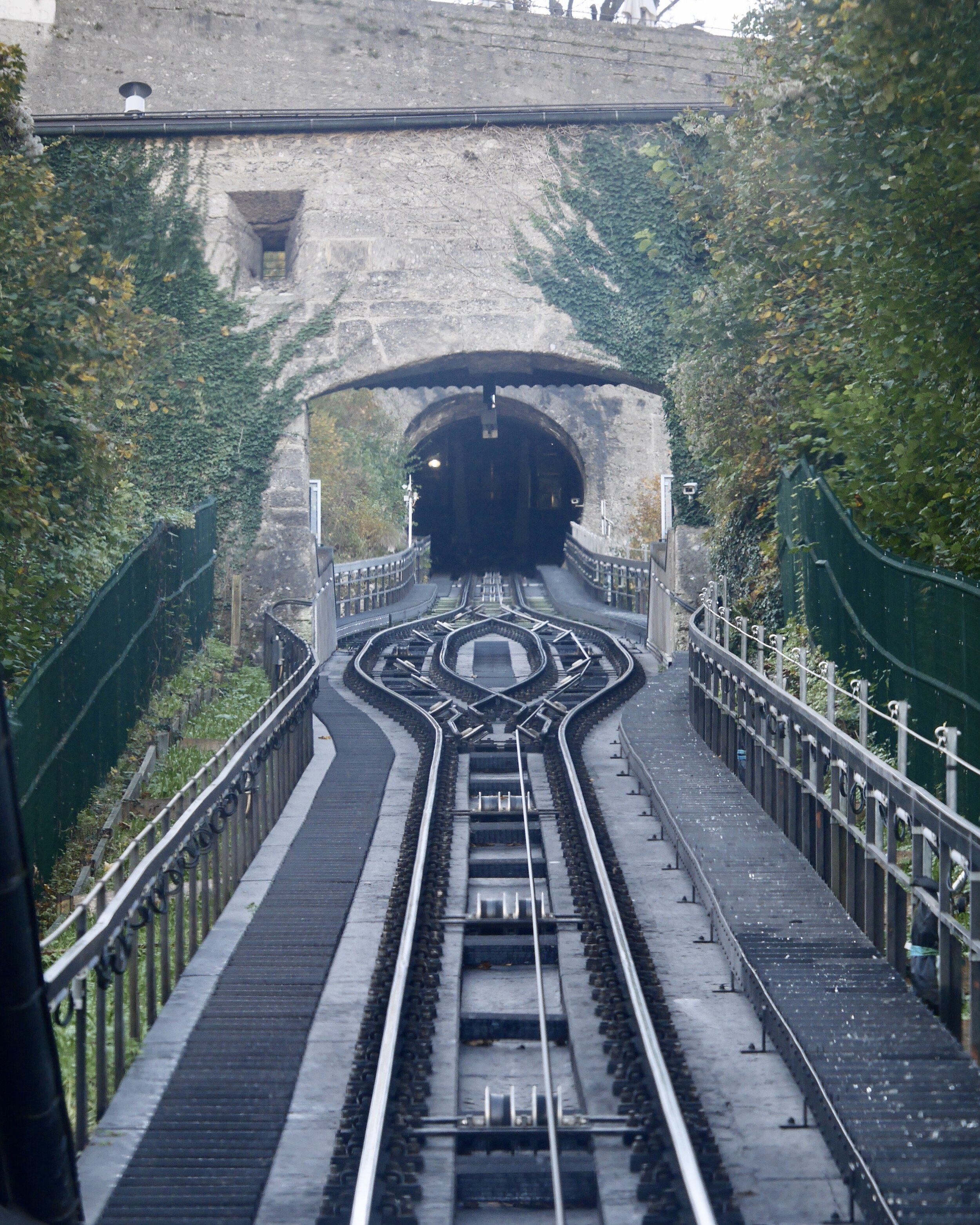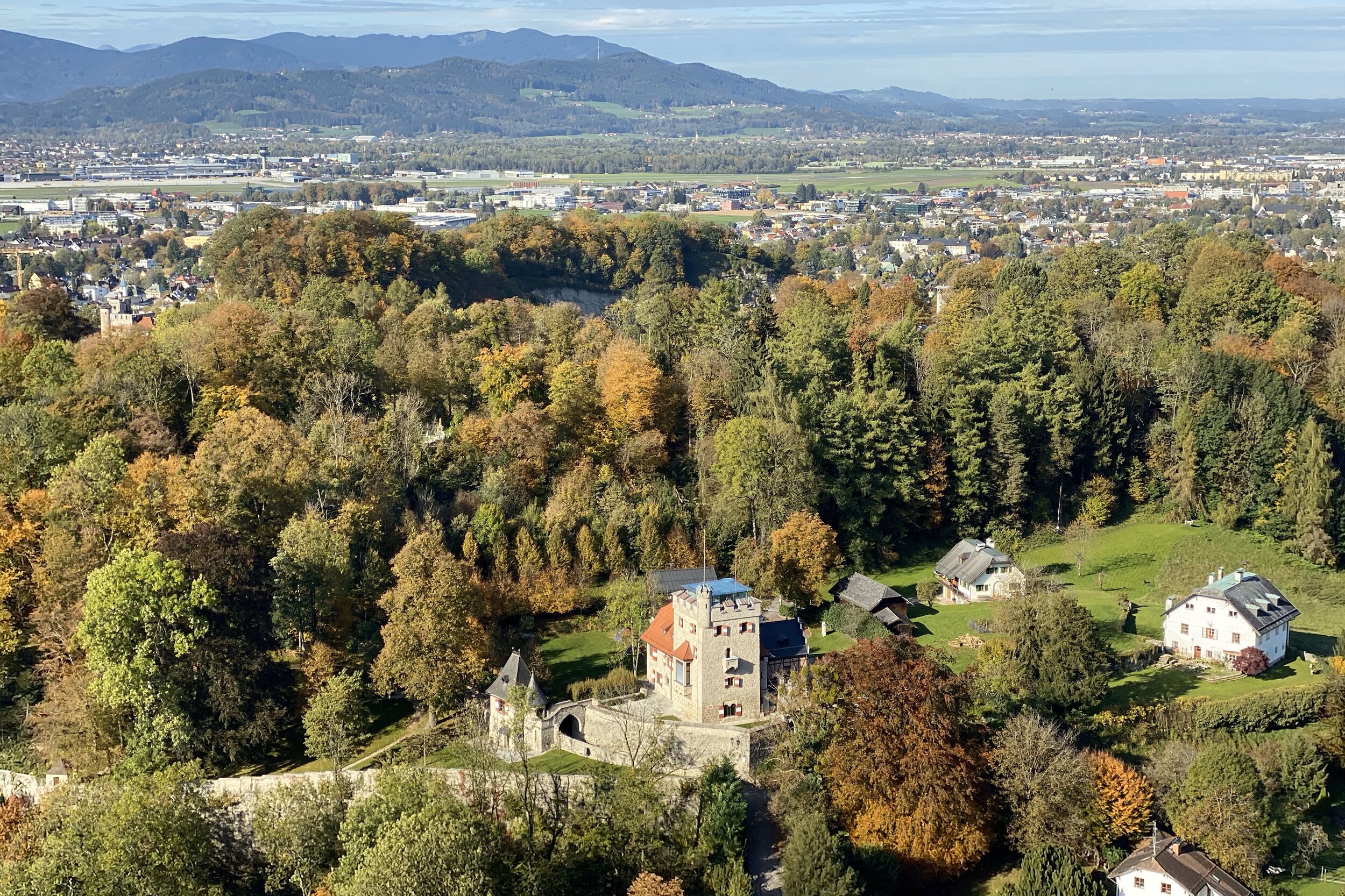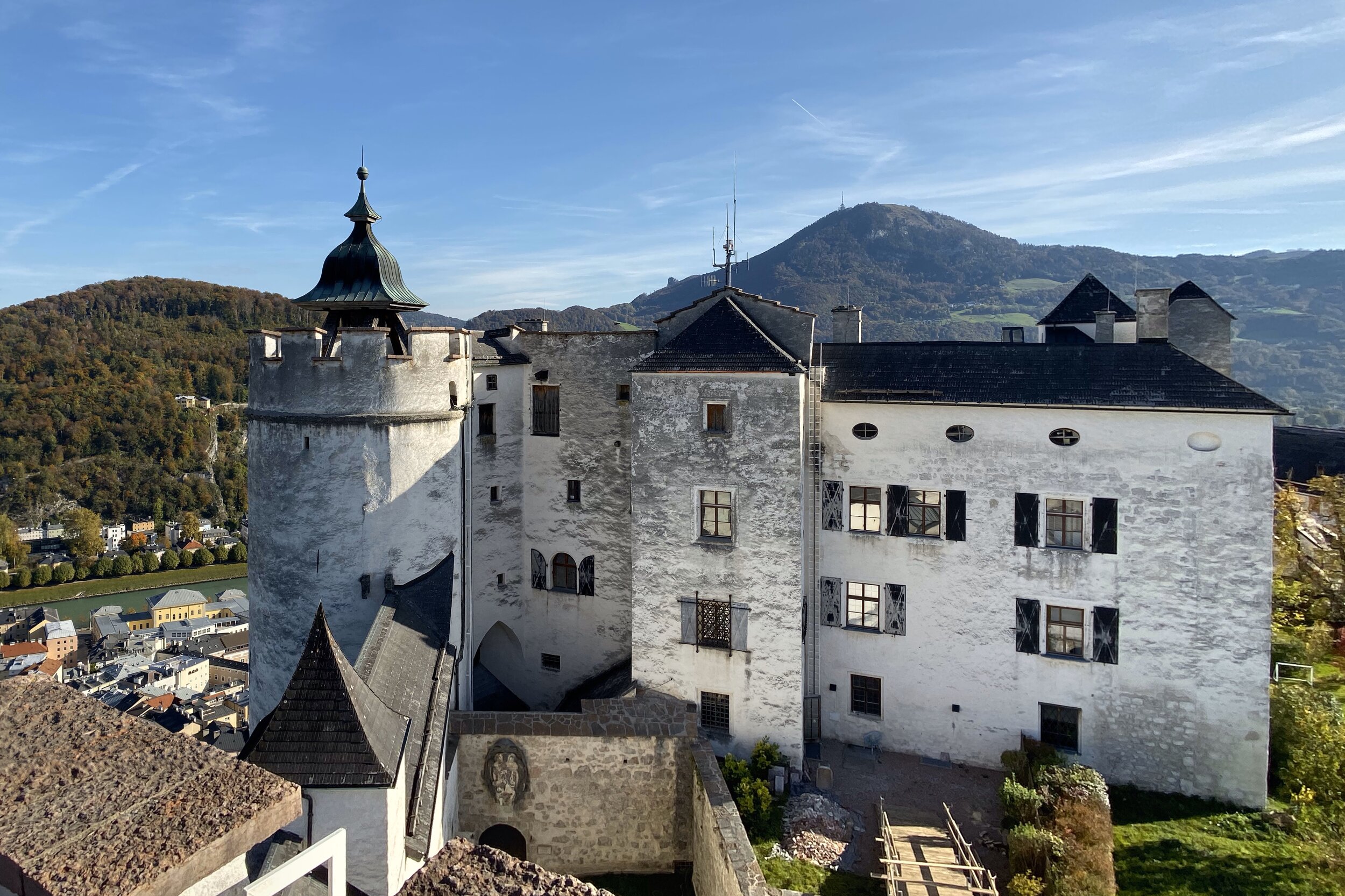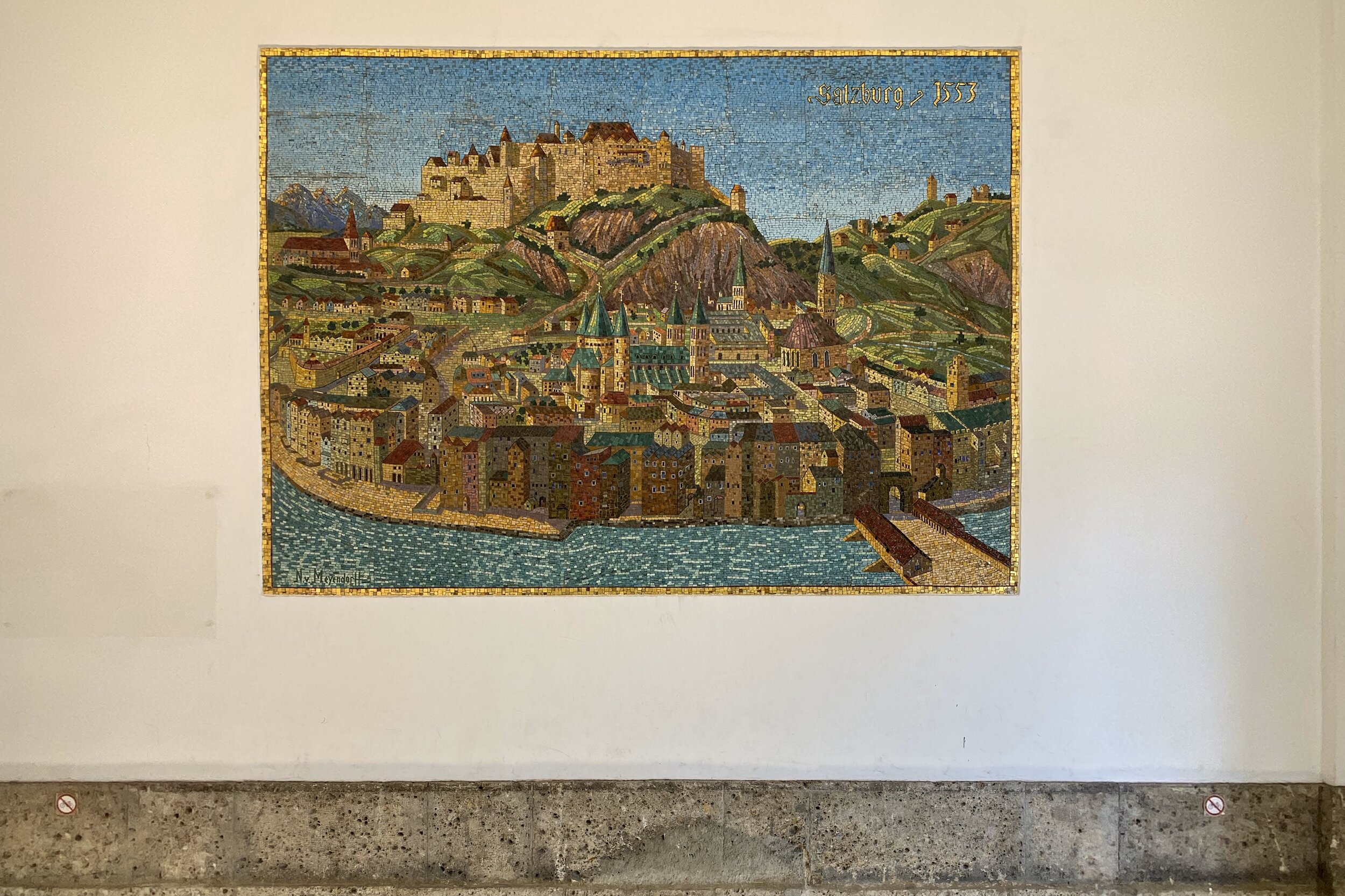Salzburg, 18 Oct 2019
On the agenda for this day we’re touring Mozart’s birth home, Hohensalzburg Fortress, and walking along Mönchsberg. Later, wanting to go to a concert in the city of Mozart, we did just that.
Since we had bought breakfast items the day before, it didn’t take us a long time to eat. We then hopped onto the bus which took us to the city center.
Mozart’s birth home
We arrived at Mozart's birth home just after they opened, and there were few people milling around. Feeling fortunate, we headed upstairs, had our Salzburg cards scanned, and were on our way into the museum.
Mozart's father, Leopold, moved into this home when he was married. After his older sister, Wolfgang Amadeus Mozart was born, soon learning to play piano and violin. He lived in the home for 25 years, after which he moved to Vienna; he died at age 35.
The museum tour starts in the actual apartment, some rooms set up to portray what a typical apartment of the day would look like, some with artifacts, such as his square piano and childhood violin, and some (purportedly) locks of his hair.
There are a couple other floors which have more exhibits, the most ambition set being of set designs for some of his operas.
Hohensalzburg Fortress
We figured Mozart's birth home wouldn't take much time, so we went to Hohensalzburg Fortress next. It sits high above the rest of Salzburg, and you can either walk up or ride the funicular. Since we figured we would be walking quite a bit, we used our Salzburg Cards to bypass the line to purchase tickets and be the first on the funicular; we took the opportunity to check out what the best view would be, and since the operator was at the top, we opted for the bottom. Not long after we took our places, about 40 or 50 more people started streaming in.
Once it started, the ride was about a minute to the top. Being where we were, everyone else needed to get off the car before we could even move (there were three compartments, but ours was the furthest from the exit). We got a chance to get our first views of Salzburg from up high.
The fortress started off of modest size in the mid-15th century. Every now and then, new walls and sections were added to make it stronger, and it was never taken by force (it did negotiate a surrender to Napolean).
Our audio tour took us through the prison tower where there was a torture chamber (although it wasn't used for that). It was, however used as a prison; the most famous prisoner was Prince-Archbishop Wolf Dietrich, who lost favor with the pope by dealing in a tolerant and pragmatic way with the Protestant businessmen and salt miners.
We next went up a spiral staircase to one of the towers, the Reckturm. There was a viewing platform even higher up that gave us commanding views all around.
The last part of the tour began with a very long walk along a battlement. The audio tour recording said that we would be walking a long way, then there was a long pause; ends up that's all that track was going to tell us.
Just before the end was the “Salzburger Bull”, which is a mechanical organ used to wake the citizens every morning. It's kind of like a player piano, but instead of holes, there were staples and pins.
There are a few museums in the fortress, so we went to a few of them. In addition to one with artifacts associated with the fortress, there was a marionette museum with several dolls, several in dioramas. We also wandered around the castle a bit, exploring the areas not on the tours.
Being done with the fortress, we got something to eat then walked across a ridge of Mönchberg towards Salzburg's Museum of Modern Art. Along the way, we happened upon an art installation with a Buddha in it.
When we got to the Art Museum, we took a peek at a James Turrell installation (it was obvious he was the artist when we first saw it). We then rode the museum's elevator down to street level. There was no cost to us thanks to our Salzburg Cards.
Concert
The plan was to go to a concert in the evening, and were thinking we would want to go to a café to hopefully get some faster internet access than the apartment we were at. By the time we got back to the room, we wanted to relax a bit, then figured the timing would be pretty tight, so we relaxed a bit, then went back to the city center without laptops.
Our first stop was to pick up tickets, since we could get a small discount with our Salzburg Cards (the only thing other than food and lodging that wasn't fully covered).
We took a quick look at some cafés to have a snack, but we were concerned about time, so instead we went to a kiosk and got an apple pretzel, siting on some steps in Universitätsplatz to eat it. After that, we were ready to head to the concert in the Old Residentz.
We were the first people in the room, which was L-shaped with a harpsichord in the corner. Since the concert was also going to have a violin, we didn’t want to sit too close to the front since Collings can get pretty loud.
The room was nearly full, probably 50–60 people. The performers came out and began the first of three Klavier-Violin sonatas. Each was two movements, and after the first movement of the first sonata, people applauded. There are several ways performers handle that, and there not only didn’t acknowledge the audience, they just plowed into the second movement while the clapping was still going on. It’s seen as a way to educate the audience that applause should be at the end of the piece.
Or it’s supposed to. The same thing happened for all three pieces, but to be fair, applause was weaker after the first movement of the other pieces.
The last movement of the last sonata was a set of variations, and Melody and I usually try to keep track of variations. This piece ha had only six, but even so, since the variations ran into each other, it wasn’t always clear where the transitions were. We were trying to decide on the third or fourth, but it was really clear when the fifth started, since it changed to a minor key, and then the sixth switched back to major and picked up the speed a bit.
We had a great time, and both performers were not only really good, but they worked well together. Of course, Melody and I positioned ourselves to see the harpsichordist’s hands, especially since we wanted to know how and why he used the two manuals (keyboards) and the stops. We figured out one which changed the tone, which we found out is supposed to make the harpsichord sound like a plucked lute. The other stops and when he used which manual were harder to figure out, but as it ends up, the other stops change which octave each manual is in, which is how the instrument has more range than the keys would indicate. You could also have the two hands playing in the same octave without needing to keep your fingers from getting tangled, as can happen with a piano.
After the concert, we got some fish and chips at a nearby Irish pub, then found our way back to the apartment, had some dessert we had in the fridge, and called it a day.




















